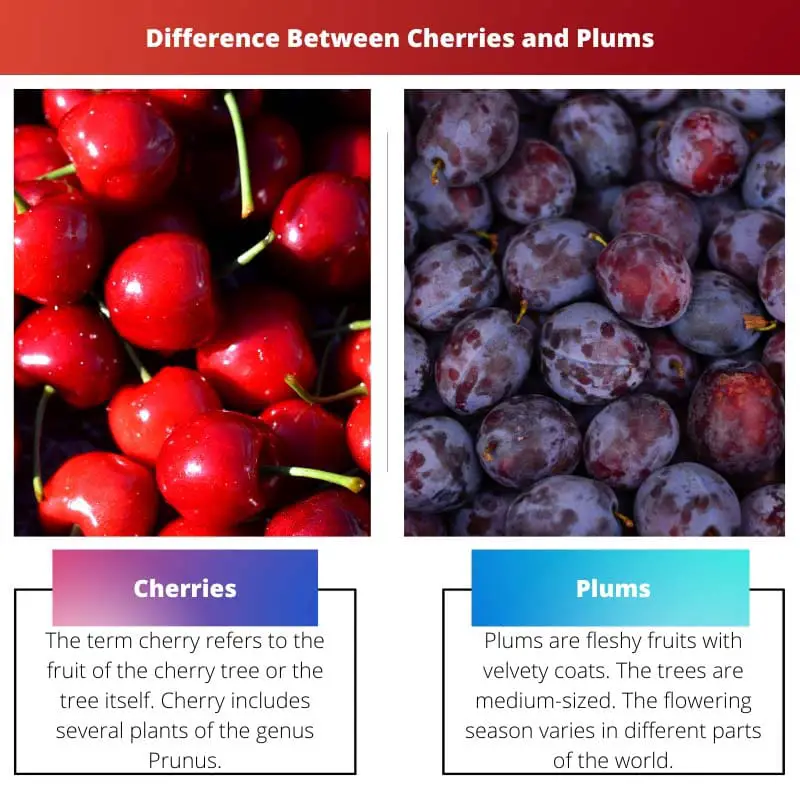Fruits are diverse. It is baffling to differentiate two closely related fruits. People consume fruits for their excellent nutritional value.
Growing your fruits and vegetables has been normalized in today’s world. Having a thorough knowledge of the type and variety of fruits makes gardening successful. Plum and cherry are the two commonly confused fruits.
Key Takeaways
- Cherries are smaller and rounder than plums, which are larger and slightly oval-shaped.
- Cherries have a single, hard pit, while plums have a smoother stone.
- Cherries are sweeter, and plums can taste sweet or tart, depending on the variety.
Cherries VS Plums
The difference between cherries and plums is that cherries are smaller than plums. Plum is dark red to purple colored whereas cherry is red usually. Cherries have a slender, long stem. Plum doesn’t have a long stem because they break off from the stem. The leaves of the plum plant have toothed edges which is absent in the cherry plant.

The term cherry refers to the fruit of the cherry tree or the tree itself. Cherry includes several plants of the genus Prunus. The cherry tree used for ornamental gardening includes cherry blossom.
Cherries make the flavor for milkshakes and cakes. They are used to garnish desserts. Cherries are a good source of Vitamin C and Beta carotene.
Plums are fleshy fruits with velvety coats. The trees are medium-sized. The flowering season varies in different parts of the world.
Plum trees bloom during the spring month of April in the United States. Plum fruits have firm and juicy flesh. The flesh surrounds the hard seed. This type of fruit is called a Drupe. Plum is eaten raw and also has a culinary role.
Comparison Table
| Parameters of Comparison | Cherries | Plums |
|---|---|---|
| Size | Small | Medium |
| Stalk | Long and slender | Short |
| Color | Red | Dark red, maroon, purple |
| Top producer | Turkey | China |
| Food | Topping for ice-cream, candied cherry, Cherry slurpy | Prunes, Damson gin, Chakapuli, Plum cakes |
What are Cherries?
Cherry was named after the place it was cultivated. The placed named Kerasous was said to have exported cherries to Europe.
Cherry cultivation began in Rome in 72 BC. King Henry VIII tasted cherries in Flanders and ordered them to plant them in England. Early settlers introduced cherries to North America.
The most cultivated Cherry types are the Sour cherry and the sweet cherry. These two species don’t undergo cross-pollination. Though there are other edible cherry varieties available, they are not cultivated for commercial purposes.
New techniques for irrigation, pruning, and harvesting have been implemented in cherry orchards. Mechanical shakers are employed in harvesting cherries.
Hand-picking is a safe method of harvesting for the fruit and the tree. A cherry plant starts producing fruits in three to four years.
However, they take seven years to fully mature. They are not suitable for tropical climates because they need chilling hours. The national cherry festival is hosted by the Australian town of New South Wales.
New varieties of cherries are developed in Australia under The Australian cherry breeding program.
Cherries are rich in antioxidants and melatonin. Tart cherry juice has a soothing effect and promotes deep sleep. Cherries along with peaches will make a healthy salad dish.
Cherries are being the well-known toppings for ice-creams and cakes. Soaking cherries in brandy is a practice in some countries. It not only preserves the fruit but also adds a tang to it. The cherry sauce drizzled over puddings enhances the look and taste.

What are Plums?
Plums are one of the first fruits to be cultivated by humankind. Fossil remains of plum have been found in Neolithic sites. Some theorized that plum was brought to Europe from Asia.
Plumtree cultivation techniques were available in an agricultural workbook from 12 the century. It indicates the presence of plum orchards in the past.
Plum trees are pruned to a height of 5-6 meters. Plum trees can reach up to a height of 12 meters if left unpruned. Fruits range between 2-7 cm in diameter.
The color and taste of plums from each part of the world are unique. Chinese and Japanese plums are the most sought after because they have a higher shelf life.
Japanese plums cannot transform into prunes. Prunes are dried plums. Hybrids of plums were developed in the United States. Besides these hybrids, Locals prefer indigenous plums and are sold in the markets.
Plum fruits fall off the tree when the weather is dry. When the weather is moist they develop fungal growth.
Plum is commonly used in Jam making. They are eaten fresh or as fruit juice. Plum wine made by fermenting plum juice is traditional in European countries.
Salt dried plums are called Saladito. Asian and international have stocks of Pickled plum. The main ingredient for the Romanian brandy called tuica is plum. People in different countries follow different methods to ferment plums and make a beverage.

Main Differences Between Cherries and Plums
- Cherries are smaller in size and naturally red. Plums are larger than cherries and maroon to purple colored
- Cherry trees have dark green leaves that are smooth towards the edges. Plum trees leaves are commonly red to purple like the fruits and have toothed edges
- Cherry buds are oval whereas, plum buds are round. Each bud is attached to the tree separately by a short stem in the case of a plum but, in cherry flowers, a cluster of buds develops from each bunch.
- Cherry flowers don’t have a strong fragrance. Whereas plum flowers have a sweet fragrance
- Cherry has several applications in cooking. They are candied, pickled, added to pies, milkshakes, cakes, etc. Plum is dried to get prunes. Plum cake, Plum jam, Plum crumbles, and Alcoholic beverages are made from plum

- https://journals.ashs.org/hortsci/view/journals/hortsci/31/1/article-p150.xml
- https://www.ingentaconnect.com/contentone/sphs/sphr/2010/00000006/00000002/art00003
